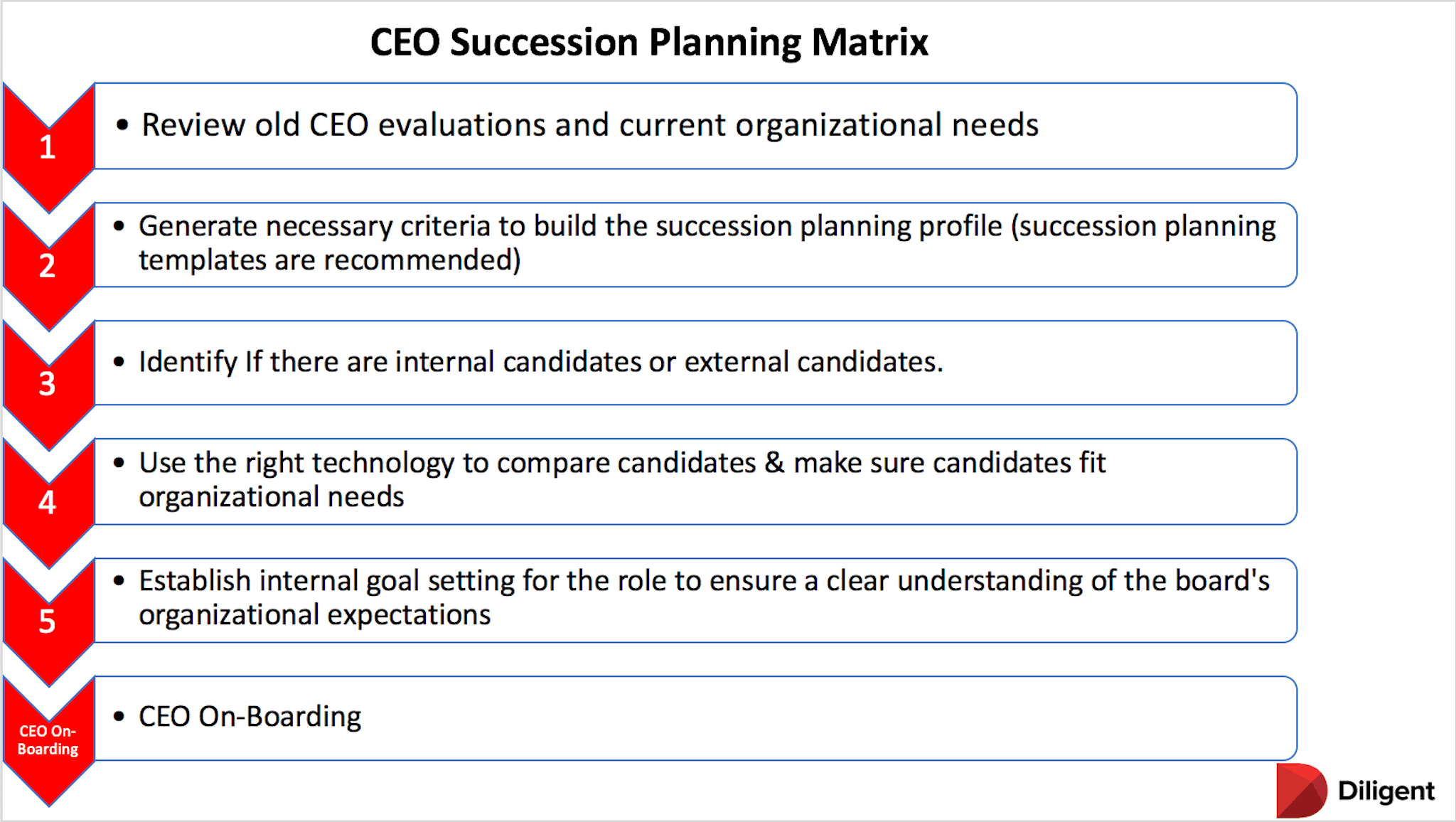CEO selection process

Getting the right CEO is crucial to the success of every organization and having the right CEO selection process should be top of mind for any board. Succession planning committees should always have a viable pool of CEO candidates in mind. At selection time, it's important to not only evaluate those candidates, but also keep an open mind to new candidates, including those whom headhunters recommend. The selection process requires good judgment, objectivity and open-mindedness. Selection teams should work diligently to clarify the essential qualities in candidates that will be needed to serve the future needs of the organization. The process requires a deep dive to assessing which candidates shine above the others in relation to the organization's needs.
The CEO selection process should be an ongoing one that targets candidates for succession and emergency replacement. CEO selection is a necessary process that can also be sensitive. Boards can help themselves keep their planning confidential by using a board management system like Diligent Boards for secure communications and collaboration between team members.
CEO Selection Process Best Practices
Use these four steps to better approach your CEO selection process:
1. Choosing the Selection Team
In a perfect scenario, the board will have formed a succession planning committee that involves the current CEO and they will meet on a regular basis. Selection committees should schedule at least an annual meeting where the team can have a comprehensive discussion about potential internal and external candidates and plan for emergency circumstances. The succession planning process should be transparent to ensure that the current CEO maintains the confidence of his or her board.
In the unfortunate event that the board lacks confidence in the incumbent CEO, or where there is a corporate crisis that raises succession issues, the lead director should become the main authority for the succession and selection process.
In seeking the best possible candidate, it goes without saying that the team should consider the traits, characteristics and experience of candidates in guiding the organization to future success. The team should also consider that while an incumbent CEO has been a perfect fit for the past term, the organization may need a different set of skills and experiences to lead the organization moving forward.
Selection teams face many challenges in making their final selection. Boards may have poor internal dynamics and underlying disagreements that prevent the team from reaching a solid point of view. Another issue that boards have is one or two members who dominate the others. When a board is unevenly balanced with respect to power, it excludes the less-dominant members from the decision-making process. Regulators and lawmakers have required or encouraged boards to have largely independent board directors on the board. A board that is too independent may not have enough experience and expertise in the industry or on the operations side of things.
2. Assessing Fit for the Organization
Finding the best fit begins with the candidates having a good understanding of the current and future requirements of the job. Candidates should know what some of the current challenges are and how the external environment is changing. Selection teams should be reading analyst reports and talking to insiders in the business, so they have a better understanding of what their organization needs. Sometimes outside experts can be helpful in expanding the team's thinking and lending insight to some of the complexities of the job.
As teams work through the process, they should be able to focus in on the critical capabilities that will make or break the company. The goal is to identify two or three capabilities that are interconnected that will be necessary for the new leader to succeed. At this point, teams should start seeing one or two candidates who stand out from the others.

3. Don't Land on a Front-Runner Prematurely
It can be tempting for teams to have one candidate in mind over the others throughout the process. It's crucial for selection team members to keep an open mind and not mentally settle on one particular candidate too early in the process. Once the team narrows the group down to two or three candidates, it's time to start with a clean slate. Team members should strive to be as objective as possible. The team should continually battle against their personal biases and assumptions, particularly if they're more familiar with one of the candidates than the others. Board directors who aren't familiar with any of the candidates should be careful not to get stuck on their first impression.
Members of the team may have some of their own choices in mind. That's fine, as long as the team vets them carefully. Team members should take care not to take anyone's recommendations as a 'given.' We live and work in volatile times and a company's needs can quickly shift. That can happen during the CEO selection process and selections teams should keep that in mind. Under the best circumstances, board directors will be able to get to know the top contenders over time. Hopefully, they get to be in the audience for their presentations and talk with them at social events.
CEOs don't necessarily need to have executive experience. Sometimes, it's preferable to look at someone younger who has a fair amount of technical prowess and who may be able to get up to speed on the other duties and responsibilities quickly.
Headhunters can sometimes be a good resource for finding candidates for the CEO position. As with any industry, some firms are more reputable than others. Use a headhunter that goes the extra mile to find the candidates with the best fit. If you keep getting former CEOs who left a disaster in the wake of their tenure at their last company, it may be time to end the contract with the headhunter firm or find a better resource. Teams should give headhunter candidates the same consideration as their other candidates and not view it as a moot exercise.
In the event that any of the candidates are well-known or have celebrity status, teams will need to look past their awe and not be influenced by the idea of filling the spot with someone notable.
4. Don't Be Afraid to Start Over
Teams should be aware that they can do everything right and still not end up with the best candidate for CEO. The best leader also has to be the best fit for the organization. What happens if, after all the interviewing, vetting and narrowing candidates down, none of the candidates truly fits the needs of the organization? Do you settle or start over?
The Importance of a Well Thought CEO Selection Process
It depends. All board directors should be comfortable with the choice no matter who it is. Sometimes the front-runner can be a great-candidate with a little mentoring or coaching. Everyone has weaknesses. As long as teams recognize what they are, sometimes there are things we can all just live with.
Effective Succession Planning with Diligent Nominations
With the spotlight on issues surrounding boardroom diversity and composition, access to data and analytics to spot opportunities to diversify your board is now a requirement. Whether or not you are already supported by consultants, enabling your Nomination and Governance committee with the right applications will lead to more effective board recruitment.